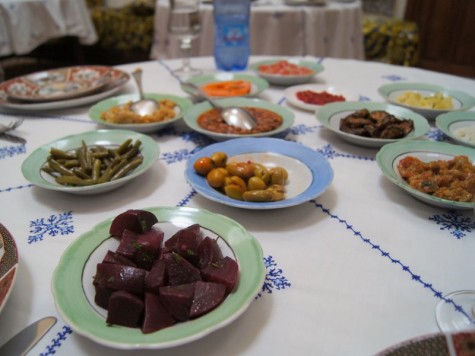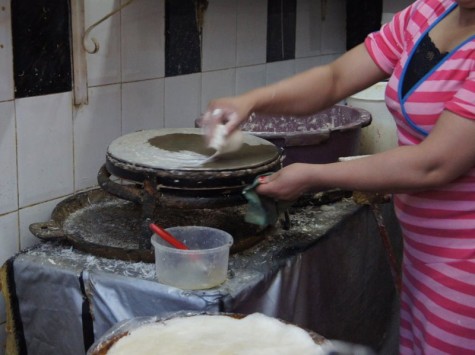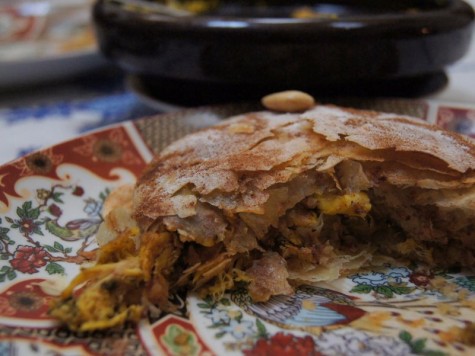Morocco is a slightly tricky place to eat. “Restaurants are OK,” everyone says, “but the best food is served in people’s houses.”
But, the skeptic in me counters, isn’t that true everywhere?
In Morocco, though, it does seem to be more true than elsewhere. Restaurants serve the same three tagines, plus couscous with seven vegetables. Oh, and there’s soup. The end. It can get a little wearing after a few days, and even irritating, just knowing that somewhere people are eating many more varied things than this.
In fact, the best meal we had was in someone’s house. Granted, it was a house where the family had turned their sitting room and courtyard into a restaurant. And the menu, at first glance, did have just the standard items on it.
But what a difference a home cook’s hand makes! Dar Hatim opened a couple of years ago in the Lahoudi section of Fes. It is genuinely the owners’ family home, and is so family-stylie that the guy, Fouad, came to collect us in his car–fortunately, because we surely would’ve gotten lost halfway there from our hotel. Once he sat us down and dashed off to pick up more guests, his wife came out and got us settled. And Fouad’s mother was upstairs in the kitchen the whole time.
We ordered a couscous with vegetables as well as bistilla, the flaky-pastry sweet-savory chicken (or pigeon) pie that’s one of the ultimate dishes of Moroccan gastronomy. We hadn’t eaten it yet on the trip, because I was leery of getting it in a sub-par restaurant. In the wrong hands, it’s a sugary, slightly creepy mess.
But first, the salads. So simple…and so many.

First, I must congratulate Meg and Emily for their exceptionally restrained eating habits throughout the trip. Even when presented with something so-so in a restaurant, I tend to finish it out of some obscure sense of duty. Which is especially misguided in a place where serving sizes are monstrous. But Meg and Em were able to eat a normal amount, and sit back, guilt-free. I only wish I could bring them to Mexico with me, to keep me in line there.
At Dar Hatim, however, they were the teensiest bit undone but the array of salads. And then Fouad’s wife came in and gently chided us: “Is that the best you can do?” she said, with a small frown. She made no motion to remove our salads, just turned away and walked back to the kitchen.
“Activating. Second. Stomach,” Em said, gamely. We each earmarked our favorites, and when our judge returned, she deemed it acceptable to move on.
To the couscous. Which, you know, isn’t filling at all. It was full of butter, and vegetables with a texture that said “cooked to death” but flavor that said “I am exactly what a dream zucchini was always meant to taste like.”
Fortunately we didn’t have to finish that before our two bistillas arrived. They were beautiful, so plump and flaky on our plates, bedecked in cinnamon, confectioner’s sugar and toasted almonds.
“Third. Stomach,” croaked Em.
There are several secrets to bistilla. One is to balance the sweet and the savory. Another is to get the moisture of the filling–a combination of chicken, eggs, herbs and stock–correct. And another is to keep the warqa, the pastry sheets, whole and properly flaky.
Warqa on their own are such an art that most sensible cooks buy them from specialists. Here’s what the process looks like, by a dedicated expert in the Fes medina:
Yes, the woman is applying gobs of dough by hand to the hot skillet–a very sticky, wet dough that leaves the barest film behind, just enough to create a translucent, slightly stretchy crepe-like thing that’s whisked off (again, by asbestos-hand) and set in a stack. According to a cookbook from the 1950s that I bought in Marrakech, it takes 140 of these sheets to make a proper family-size bistilla, about as big around as a small coffee table.
Fortunately, Dar Hatim’s bistillas are single-serving (er, allegedly), so require a slightly fewer sheets of warqa. We managed to eat just about all of ours.
Emily looked truly sad as she left her last bit untouched. Fouad’s wife had mercy and did not chide us this time. After dinner, she invited us upstairs to see the kitchen–just a regular home kitchen, with the addition of a nice oven for the bistilla. We groaned slightly as we hauled up and down the stairs. I, at least, was slightly relieved we’d had only this one meal in a house. I’m not strong enough for many more.

